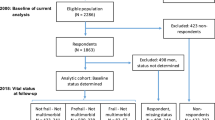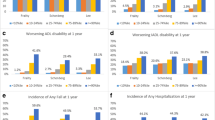Abstract
Background and aims: Mortality at older age, during and after hospitalization, can be determined by several factors, beyond the direct cause for hospital admission, which are not yet fully understood. The aim of this study was to assess predictors of inpatient mortality and one-year mortality in older Italians, hospitalized for dementia, heart failure, chronic obstructive pulmonary disease, stroke, hip fracture and myocardial infarction at the Verona Teaching Hospital, Northern Italy. Methods: At admission, 429 patients aged 65 years and older reported information on: sociodemographic characteristics, Barthel index at admission and two weeks before, and severity of investigated diagnosis; at discharge: diagnosis, comorbid conditions, complications from hospital records, drug therapy, and Barthel index. One year after discharge, an ad hoc questionnaire for those subjects found to have died on phone contact was administered to a proxy to collect data on new hospital admissions, onset of new conditions, need for formal care, a short version of the Barthel index one month before death, and the place of death. Results: Sex and specific diseases at admission were not significant predictors of inpatients, nor was one-year mortality in this cohort, whereas the presence of any comorbid conditions doubled the risk of mortality at one year compared with patients without comorbidity. Those patients who had moderate to severe/total dependency in ADL at admission were three times more likely to have died at discharge than those who were independent. The same risk for mortality at one-year follow-up was found in those patients who were severely or totally dependent at preadmission, at admission, or at discharge. Conclusions: Functional status and comorbidity are key risk factors for mortality in the elderly. Therefore, multidimensional assessment, including functional status prior to hospitalization should always be assessed, and should be considered a relevant predictor of short- and long-term outcomes.
Similar content being viewed by others

References
Taroni F, Bevan G. I gruppi di diagnosi isorisorse (DRG) per la valutazione dell’attività ospedaliera. In Borgonovi E. L’azienda Sanità. Milano: Angeli, 1987: 164–90.
Rosenthal GE, Landefeld S. Do older Medicare patients cost hospitals more? Evidence from an Academic Medical Center. Arch Intern Med 1993; 153: 89–96.
McVey L, Becker PM, Saltz CC, et al. Effects of a geriatric consult team on functional status in elderly hospitalized patients. Ann Intern Med 1989; 110: 78–84.
Hirsch CH, Sommers L, Olsen A, et al. The natural history of functional morbidity in hospitalized older patients. J Am Geriatr Soc 1990; 38: 1296–303.
Iezzoni LI, Greenberg LG. Risk adjustment and current health policy debates. In Iezzoni LJ, Ed. Risk adjustment for measuring health care outcomes. Ann Arbor. MI: Health Administration Press. 1994: 347–52.
Narain P, Rubenstein LZ, Wieland GD, et al. Predictors of immediate and 6-month outcomes in hospitalized elderly patients. The importance of functional status. J Am Geriatr Soc 1988; 36: 775–83.
Teno JM, Harrell FE, Knaus W, et al. Prediction of survival for older hospitalized patients: the HELP survival model. Hospitalized Elderly Longitudinal Project. J Am Geriatr Soc 2000; 48: S16–24.
Sager MA, Rudberg MA, Jalaluddin M, et al. Hospital Admission Risk Profile (HARP): identifying older patients at risk for functional decline following acute illness and hospitalization. J Am Geriatr Soc 1996; 44: 251–7.
Covinsky KE, Palmer RM, Counsell SR, et al. Functional status before hospitalization in acutely ill older adults: validity and clinical importance of retrospective reports. J Am Geriatr Soc 2000; 48: 164–9.
Sager MA, Franke T, Inouye SK, et al. Functional outcomes of acute medical illness and hospitalization in older persons. Arch Intern Med 1996; 156: 645–52.
Hannan EL, Magaziner J, Wang JJ, et al. Mortality and locomotion 6 months after hospitalization for hip fracture: risk factors and risk-adjusted hospital outcomes. JAMA 2001; 285: 2736–42.
Dunham NC, Sager MA. Functional status, symptoms of depression, and the outcomes of hospitalization in community-dwelling elderly patients. Arch Fam Med 1994; 3: 676–80.
Fortinsky RH, Covinsky KE, Palmer RM, et al. Effects of functional status changes before and during hospitalization on nursing home admission of older adults. J Gerontol 1999; 54: M521–6.
Nierman DM, Schechter CB, Cannon LM, et al. Outcome prediction model for very elderly critically ill patients. Crit Care Med 2001; 29: 1853–9.
Wu AW, Yasui Y, Alzola C, et al. Predicting functional status outcomes in hospitalized patients aged 80 years or older. J Am Geriatr Soc 2000; 48: S6–15.
Hermann-Lingen C, Klemme H, Meyer T, et al. Depressed mood, physician-rated prognosis and comorbidity as independent predictors of 1-year mortality in consecutive medical inpatients. J Psychosom Res 2001; 50: 295–301.
Mahoney F. Barthel D. Functional evaluation: the Barthel Index. MD State Med J 1965; 14: 61–5.
Granger CV, Albrecht GL, Hamilton BB. Outcome of comprehensive medical rehabilitation: measurement by PULSES Profile and the Barthel Index. Arch Phys Med Rehabil 1979; 60: 145–54.
SAS, release 8.00, SAS Institute Inc., Cary, NC, USA.
Daley J, Jencks S, Draper D, et al. Predicting hospital-associated mortality for Medicare patients: A method for patients with stroke, pneumonia, acute myocardial infarction, and congestive heart failure. JAMA 1988; 260: 3617–24.
Greenfield S, Aronow HU, Elashoff RM, Wantanabe D. Raws in mortality data. The hazards of ignoring comorbid disease. JAMA 1987; 257: 2766–70.
Roubenoff R. Sarcopenia: a major modifiable cause of frailty in the elderly. J Nutr Health Aging 2000; 4: 140–2.
Zuliani G, Romagnoni F, Soattin L, et al. Predictors of two-year mortality in older nursing home residents. The IRA study. Aging Clin Exp Res 2001; 13: 3–7.
Walter LC, Brand RJ, Counsell SR, et al. Development and validation of a prognostic index for 1-year mortality in older adults after hospitalization. JAMA 2001; 285: 2987–94.
Fortinsky RH, Covinsky KE, Palmer RM, et al. Effects of functional status changes before and during hospitalization on nursing home admission of older adults. J Gerontol 1999; 54: M521–6.
Author information
Authors and Affiliations
Consortia
Corresponding author
Additional information
For the list of members, see Appendix
Rights and permissions
About this article
Cite this article
Minicuci, N., Maggi, S., Noale, M. et al. Predicting mortality in older patients. The VELCA Study. Aging Clin Exp Res 15, 328–335 (2003). https://doi.org/10.1007/BF03324518
Received:
Accepted:
Published:
Issue Date:
DOI: https://doi.org/10.1007/BF03324518



